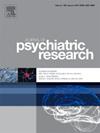Comorbidity characteristics of PTSD with anxiety and depression in patients with accidental injuries: Findings from joint cross-sectional and longitudinal studies
IF 3.2
2区 医学
Q1 PSYCHIATRY
引用次数: 0
Abstract
Background
This study aims to analyze the dynamic symptom interaction pathways and temporal causal relationships among post-traumatic stress disorder (PTSD), anxiety, and depression in patients with accidental injuries, and to establish a system of psychological intervention targets for this population.
Methods
This prospective longitudinal study was conducted from November 2023 to December 2024 in three tertiary general hospitals in Southwest China. Baseline assessments were completed 3–10 days post-trauma (T0), followed by follow-ups at 1 month (T1), 3 months (T2), and 6 months (T3).
Results
382 patients who completed T1 follow-up were included as the main analysis samples. The comorbidity rates of PTSD, anxiety and depression decreased gradually (T1 = 22.8 %, T2 = 21.2 %, T3 = 15.6 %). The longitudinal psychopathological network analysis showed that PTSD9 (Loss of interest) and D1 (Anhedonia) (edge weight = 0.22) were the main connections in T1 stage. In T2, A3 (Worrying) and D6 (Depressed mood) (edge weight = 0.30) were added. At T3 stage, there were positive emotional correlation between A4 (Relaxed feeling) and D7 (Enjoyment of activities) (edge weight = 0.21). Cross-lagged panel model analysis indicated that depressive symptoms positively predicted subsequent PTSD symptoms (T1 → T2: β = 0.583, P < 0.01; T2 → T3: β = 0.792, P < 0.05) and anxiety symptoms (T1 → T2: β = 0.268, P < 0.05; T2 → T3: β = 0.282, P < 0.001).
Conclusion
There was a dynamic evolution of PTSD, anxiety, and depression following accidental injuries, highlighting the need to establish temporally targeted intervention pathways to disrupt the pathogenic process.
意外伤害患者PTSD伴焦虑和抑郁的共病特征:来自联合横断面和纵向研究的结果
本研究旨在分析意外伤害患者创伤后应激障碍(PTSD)、焦虑和抑郁之间的动态症状相互作用途径和时间因果关系,并建立针对该人群的心理干预目标体系。方法于2023年11月至2024年12月在西南地区三所三级综合医院进行前瞻性纵向研究。基线评估在创伤后3 - 10天(T0)完成,随后随访1个月(T1)、3个月(T2)和6个月(T3)。结果382例完成T1期随访的患者作为主要分析样本。PTSD、焦虑、抑郁的合并症发生率逐渐下降(T1 = 22.8%, T2 = 21.2%, T3 = 15.6%)。纵向精神病理网络分析显示,PTSD9(兴趣丧失)和D1(快感缺失)(边权= 0.22)是T1期的主要连接。T2加入A3 (Worrying)和D6 (depressive mood)(边权= 0.30)。在T3阶段,A4(放松感觉)与D7(活动享受)之间存在正相关(边权= 0.21)。交叉滞后面板模型分析显示,抑郁症状正预测后续PTSD症状(T1→T2: β = 0.583, P < 0.01; T2→T3: β = 0.792, P < 0.05)和焦虑症状(T1→T2: β = 0.268, P < 0.05; T2→T3: β = 0.282, P < 0.001)。结论意外伤害后创伤后应激障碍、焦虑和抑郁的动态演变,强调需要建立暂时有针对性的干预途径来破坏致病过程。
本文章由计算机程序翻译,如有差异,请以英文原文为准。
求助全文
约1分钟内获得全文
求助全文
来源期刊

Journal of psychiatric research
医学-精神病学
CiteScore
7.30
自引率
2.10%
发文量
622
审稿时长
130 days
期刊介绍:
Founded in 1961 to report on the latest work in psychiatry and cognate disciplines, the Journal of Psychiatric Research is dedicated to innovative and timely studies of four important areas of research:
(1) clinical studies of all disciplines relating to psychiatric illness, as well as normal human behaviour, including biochemical, physiological, genetic, environmental, social, psychological and epidemiological factors;
(2) basic studies pertaining to psychiatry in such fields as neuropsychopharmacology, neuroendocrinology, electrophysiology, genetics, experimental psychology and epidemiology;
(3) the growing application of clinical laboratory techniques in psychiatry, including imagery and spectroscopy of the brain, molecular biology and computer sciences;
 求助内容:
求助内容: 应助结果提醒方式:
应助结果提醒方式:


